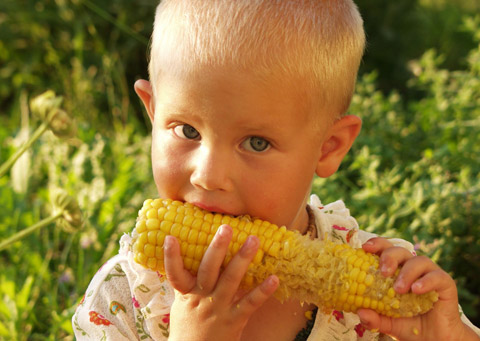

In 2009, 75% of the soy grown in the world was genetically modified. Between 1996 and 2007, areas of GMO crops (genetically modified organism) were multiplied by more of 100 ! (see chart below). GMOs are increasingly more ground on other modes of culture and breeding. From this observation we will define this folder the risks and dangers that have plants and animals genetically modified to health and the environment. Attention, This is not an exhaustive list (having regard to the scope and complexity of the topic). Will also keep you regularly informed of the topicality of GMOs.
Firstly, what is a GMO ?
A GMO is a genetically modified organism, It means that he has suffered a change in its genetic heritage by humans to confer new properties. Changing the genetic characteristics by addition, deleting or replacing at least one gene.
A transgenic organism is an organism that does not exist as such in nature, It is a completely artificial organization.
GMOs are used in the sectors of industry, from medicine, from agriculture and the food industry. We will focus here on the last two areas.
A bit of history and figures
It is in the beginning of the 1980 that we succeed for the first time to genetically modify a plant and an animal.
In 1994, the first genetically modified plant (PGM) is marketed.
TO starting from 1996 It is the beginning of the cultivation of GMOs in the field. Since, dozens of varieties (cotton, corn, beet, potato, soy, rice, wheat, tomato, etc.) and animal (salmon, pork, Rabbit, etc.) have seen the day.
THE ISAAA (International Service for the Acquisition of Agri-biotech Applications) says that in 2010, one billion cumulative hectares were cultivated with GMO crops worldwide !
Here's a map of the producers of GMOs in 2009 :
Here are the statistics that show the evolution of GM crops in the world :
Genetically modified plants
“99% agricultural GMOs are plants with pesticides, that is to say, plants that go, either produce an insecticide to resist a pest, soit qui vont être capable d’absorber un herbicide sans mourir” explique Christian Velot, Senior Lecturer in molecular genetics (Univ. Paris-Sud XI), researcher at the Institute of genetics and microbiology (Scientific Center of Orsay). So appeared the Soybeans Roundup for example. The Round-Up is a total herbicide, It means that it kills all plants except those genetically designed to resist.
The 1% remaining are plants resistant to viral diseases, mushroom, etc. Studies are underway, for a number of years, to create plants adapted to hostile environments (arid environments, Salins, etc.).
Genetically modified animals
Genetically modified salmon is a good example. Has been added to Atlantic salmon growth hormone gene and another gene so it can even grow in the cold waters. The speed of growth is 30 to 60% higher and fish would be ready to be eaten in 19 months instead of 3 years for the ordinary farmed salmon. In autumn 2010, the FDA (Food and Drug Administration) also expressed itself on this subject : "there are reasonable certainty that the consumption of food from this animal is not detrimental to health.. This was immediately reacted as consumer organizations Food and Water Watch : “nous ne voyons pas comment on peut assurer que ce produit n’est pas nocif sur la base de quatre études, dont trois sont menées par la société d‘élevage”.
Pigs Giants have also been established. They have a growth rate and higher adult size 40% While their diet would 25% lower ! Of giant rabbits, of chickens without feathers and goats producing silk are other examples of what is being done in genetic engineering.
Problèmes environnementaux – Augmentation des traitements
There arises some environmental problems with the cultivation of GMOs. Indeed, comme les variétés de plantes “Round-Up Ready”, so resistant as we have seen in the Round-Up, do not undergo the herbicide damage, the farmer is generally less attention to the dose of herbicide that it will spread. It will prefer to put more to be sure, because its culture will be Anyway spared. We have huge crops in the United States for example, farmers who apply pesticides by plane, watering the surface of pesticides. Round-Up to the United States and the Canada consumption has increased dramatically since the placing on the market of transgenic varieties, doing the happiness of Monsanto that sells both GMO and seed herbicide that goes with.
USDA Photo : Charles O'rear
Plants with modified nutritional values
Some plants have been designed to provide nutritive qualities that they do not naturally. This is the case of golden rice that has been modified to produce vitamin A. It is called golden rice because of beta-carotene that makes its yellow-orange color. The problem here is to know whether the plant in question produces still and if so, in what quantities, nutrients that it produced normally (Vitamin E, chlorophyll, gibberellic acid).
Plants with pesticides
There is also the question of these plants that are designed to produce their own pesticide. The idea is at first sight rather good because the farmer would no longer need to use this pesticide in question because the plant factory alone. The problem mentioned by Christian Velot is the impact that this plant has on the environment and on the health of the consumer. Indeed, the plant automatically produces a pesticide and root discontinues this substance in soil. Pesticides are, normally, épandus en prévention ou lorsqu’il y a un problème alors qu’Here the plant created continuously in all circumstances, so even in the absence of the problem. What then is the ecological benefit if the plant creates this substance and injects it itself into the environment ?
Accumulation of pesticides in plants with pesticides
Another problem posed by these plants is the accumulation of these pesticides in tissues. What then are the implications on the animal who eats them and the man who will eat the animal ? “Pour les plantes à pesticides There is no European legislation, c’est à l’appréciation des instances d’évaluation” qui peuvent décider si des tests doivent être faits ou non, explains Christian Velot. In cases where studies are made, “pour des raisons de secret industriel It is the seed firm that chooses the laboratory qui fera ces tests” et the results are not communicated for the same reasons (except in rare legal proceedings). The plant should not only be tested as a plant but also as a pesticide. This clearly demonstrates a lack of transparency, What is unacceptable.
Development of disease or resistant insects
In not producing plants resistant to certain insects or diseases, they will adapt. The vast majority will be killed but some insects naturally resistant to the pesticide will proliferate and take over. This minority of insects among the species will then become the majority, thus changing the species in a non-natural way. This is the case for example of maize MON810, BT cotton that is more resistant to the pest butterfly for which it was designed, suddenly the farmers are forced to use increasing amounts of pesticides against insects resistant. There are even other insects that now ravage cotton crops finds a scientist rather pro GMO, Dr. Kranthi.
We are also able to ask what impact a plant GMOs on non-pest insects, on surrounding plants, impact is not expected to have but that she still.
Yet very small performance gain
The main argument of defenders of GMOs is claim to be much more efficient with their GM seeds and thus be able to feed the starving. But scientists and experts concluded otherwise. "So far the performance of genetically modified crops to improve yields are modest and this despite considerable efforts being implemented. [for twenty years], finds the independent American research UCS group (Union of Concerned Scientists). "No transgenic crop did a real increase in performance. and only Bt corn has shown a certain extent of larger returns of exploitation"says Doug Gurian-Sherman lead author of the study of the UCS. According to reports, the earnings of BT corn, for example, are only of 3 to 4% ! The fact that cultures have best performance is more due to crop techniques that evolved much over the past 20 years.
Genetic pollution of animals
In the same way, If a transgenic salmon 5 to 6 times the normal size is released into the wild, There would be significant consequences for the environment. It will tackle larger fish, He will eat the fish with whom he had cohabited, It is more than wild fish mate (car les femelles préfèrent les mâles plus gros…), etc. Very quickly he would most have large salmon because they would take the place of the other. We have a glimpse of what may be the introduction of an alien species in an ecosystem with the Darwin's nightmare, for example, where the Nile perch (species non-GMO) has everything ravaged.
To control everything as stated by major groups is impossible. It is not unusual that thousands of farmed fish escape accidentally into the nature (during a big storm for example), It will be of course similarly with genetically modified fish. Claim, as the bottom multinationals, sterilize millions of fish they create seems utopian.
Genetic pollution of plants
There is the problem of genetic contamination of plants. Pollen or seeds of the PGM will contaminate other plants nearby by the wind, insects, birds, etc. Bio cultures can thus be contaminated and lose their label and shall be sold as GM. This is a threat to the biodiversity of the planet. The genetically modified plant, who is stronger, will take over on the ancestral natural species and the risk is to see disappear from the unique varieties by random mating with artificial plants. “D’un point de vue environnemental, les OGM participent à l’appauvrissement de la biodiversité et sont le reflet d’une agriculture industrielle” says the Confederation Paysanne.
The impact on health
There are many who claim that GMOs are safe for health. The EUnited States and the Canada consume indeed over the years 1996. However, it is totally impossible to know if GMOs have negative effects on health car le terme “organisme génétiquement modifié” n’apparait sur aucun emballage d’aliment. It is therefore impossible for a doctor to establish the link of cause and effect of a GMO. Millions of people consume every day without knowing it ! This extensive experimentation on humans is even really a, car il n’existe pas de groupe “témoin” ne mangeant pas d’OGM mais vivant dans les mêmes conditions, in order to determine if GMOs have effects on health. As it is something relatively new, We can ask ourselves if there will not be consequences over the long term, in 20 or 30 years.
Controversial studies
There are only very few studies on GMOs because studies are very expensive, complexes to realize and take years of experimentation. This has not prevented the Governments and organizations of consumer protection to allow animal and human GMO consumption since 15 years ! The reason for which the placing on the market was as fast, often even before actual serious studies are conducted, is that companies want to market as quickly as possible their GMO. Faster they will sell more quickly they will recover their investment. Are the increase of chronic diseases and the weakening of the immune system consequences of GMOs ? It is hard in these terms to know, even if some scientists assume.
A few examples of studies (independent) already carried out
Terje Traavic, Institute of Gene Ecology molecular biologist, affirme qu’ “un des risques majeurs est que 95% scientists working for the industry and that 5% only are really independent“.
In 2007, a study conducted during 3 month by the CRIIGEN (Committee for research and independent Information on genetic engineering) reveals 60 significant differences between the rats consuming the genetically modified maize (NK603, corn developed by Monsanto to resist the Round-Up) and the control group rats. The differences affect the kidneys, the brain, the heart, the liver and the weight animals. These findings “pourraient être des signes avant-coureurs de toxicité” says Greenpeace. [4] The CRIIGEN analyzed request for authorization of this maize from Monsanto and finds that further studies should be made.
Another study conducted during 3 months in rats in 2007, concerning other transgenic maize from Monsanto (MON863), shows that rodents are also signs of toxicity at the level of liver and kidneys. [4]
In 2008, the University of Vienna in Austria has shown that the 3rd generation of mice fed Monsanto's GM corn (NK603 x MON810) had more difficulties to reproduce. In addition, the number and weight of small were lower.
The CRIIGEN issued end 2009 a study on three GMOs : MON810, the MON863 and the NK603. Here's the CRIIGEN says in a press release : “pour la première fois au monde, confidential Monsanto tests allowing international authorities of three GMO marketed were contre-expertisés by the CRIIGEN researchers, the University of Caen and Rouen. These GMOs produce insecticides (MON810, MON863) or absorb the weedkiller Roundup (NK603)” et rajoute “cette publication internationale montre des effets particuliers liés à la consommation de chaque OGM, different by sex and dose. They are related to livers and kidneys, the main bodies reacting during chemical food poisoning. Other effects touch the heart, adrenal, the spleen and blood cells. […] Also short tests and if few animals studied by group cannot provide final proof of safety or toxicity, they are, however, quite disturbing to claim that studies are redone on a longer, sur plusieurs espèces et générations avec un nombre d’individus garantissant une puissance suffisante des tests statistiques”.
Click the link below to listen to the audio clip of journalist, Editor Sébastien Portal [5] :
GMO - Russian study that could uproot an industry
The era of experimentation
In the words of Christian Velot, “on ne maitrise rien ou pas grand-chose” et il va plus loin en affirmant qu’ “il n’y a pas un seul scientifique au monde, and regardless of the number of prizes Nobels that he could earn his career, who would be able to identify comprehensively the consequences in the short, moyen ou long terme d’une modification génétique sur un métabolisme”. The field of genetics is so complex that scientists are testing to replace a gene and see that it has the effect.
A marker gene is introduced : antibiotic resistance gene. “Il n’est pas éliminé à posteriori, il reste dans la plante” affirme Christian Velot. The question is also whether that becomes this antibiotic in the body of the animal or the person who eats the plant.
Uncontrolled side effects. Most of the genetically modified animals are already not viable. Others develop new features and not expected. Fish Tylapia for example is a freshwater fish, the genetically modified Tylapia which grows twice faster, happens to live in salty water. What will happen if this fish arrives accidentally in the seas and oceans where in normal times he would die ?
Seed testing and patenting of life
Patent a plant allows a company to simply appropriate it.
Many patents on gene sequences, micro-organisms or GMOs are held by large firms. The patentability of life is a source of many controversies. For ethical reasons, patenting the living in order to make it an object of merchandising is to much nonsense. Patented seed helps multinationals, like Monsanto for example, to have the control over the peasants who do not have the right to sow the seeds from one year to another under penalty of prosecution. It must therefore in buys every time the firm news. “Les OGM ne sont pas une solution au problème de la faim dans le monde, as would have us believe the seed industry. On the contrary, by the system of patenting of seeds, they keep the peasants in economic dependency, by forcing them to buy seed each year“, exclaims the Confederation Paysanne.
In other words, “la conséquence du brevetage du vivant est que le produit breveté appartient au détenteur du brevet et que toute personne tiers désirant utiliser ce produit doit rémunérer financièrement le propriétaire” [6].
Another consequence is that companies like Monsanto will in poor countries or developing and take ownership of the active substances of medicinal plants local. This is called the “biopiratage” industrial.
Reactions
“Le processus qui consiste à nous imposer les OGM sur la planète est un processus antiscientifique et antidémocratique […] si la planète est déjà une vaste poubelle ce n’est pas une raison pour en faire une vaste paillasse de laboratoire”, Christian Velot.
"It is scandalous that these are companies that not only lead the studies on their products but that they are also analyzing the results ! », Arnaud Apoteker, GMOs of Greenpeace France campaign.
« Highlighting of negative impacts of GMOs on the reproduction of beings living is new and extremely worrying ! Many regulatory authorities, as theEFSA in Europe, have yet considered them safe based on short-term studies provided by the industrial... It must urgently withdraw from the market the suspect products and complete re-evaluation of the GMO process initiated by the French Presidency of the EU. We are not Guinea Pigs ! », Arnaud Apoteker.
«The CRIIGEN denounces the previous opinions of the EFSA., AFSSA (devenu l’HANDLES) and the CGB, European and french food safety committees, who commented on the absence of risks on these tests of 90 days only, for which they do not analyzed themselves in detail statistics., CRIIGEN.
“The impact on the environment (genetic contamination) and the potential health risk (yet poorly known due to the lack of studies on the subject) are too serious to leave the seed industry to appropriate our environment, our agriculture and the future of our food », Confederation Paysanne.
Similar articles :
Main sources :
- www.Monsanto.fr
- Conference of Christian Velot, Toulouse 2005, “Les OGM, What is ?”
- Documentary : OGM – Les monstrueux animaux de la génétique
- [3] www.Greenpeace.org/France/Campagnes/OGM
- [4] www.Greenpeace.org
- [5] www.sebastienportal.com
- [6] www.infogm.org
- CRIIGEN
- www.OGM.gouv.qc.ca
- Free photos
USDA Photo : Charles O'rear
Recent Posts
Cakes, Candy : Warning on nanoparticles
100 % tested products contained nanoparticles ! [...] Les résultats de cette expérience ont…
How to eliminate toxins ?
After a series of festive meals, caloric menus, alcoholic or carbonated drinks,…
Plastic, not so fantastic!
Plastic pollutes the environment, we all know it. Il faut aussi rappeler que les objets…
How to eat healthy during lunch break ?
At work, lunch breaks are often done on the go, en quelques minutes et…
Eat healthy, it's really possible ?
These last years, le bio et le sain se sont imposés avec insistance dans nos…
Sausages and merguez salmonella
The company L’Atelier du Valois has recalled batches of "Plateau variegated" suite…




View Comments
Merci pour cet article qui englobe bien les différents problèmes liés à ces ogm... Pourvu que les gouvernements mettent de l'ordre dans tout ça, because at the moment private companies, and in particular Monsanto, n'ont évidemment aucun intérêt, without external pressures, à contrôler davantage les risques qu'engendrent leurs produits.
An enriching article..
J'aurais un question:
Quels sont les arguments qui ont conduit à limiter les cultures d'OGM???
Merci d'avance pour vos réponses
You therefore know nothing about GMOs but treat them as the worst cancers. La vérité est que les OGM existent depuis l'antiquité : It then changed plants by hybridization. We continue to make in France (the Tilling technique) but it is very bad at GMOs, donc on explique à tout le monde que c'est très très mauvais, without any evidence, and we do everything to ban. And if possible we play on the transgenic, ce qui n'a aucune rapport, and it exaggerates all figures (salmon 6 times bigger, Ben see, Why not salmon from 3 tonnes also).
All this for the economic interests of the french laboratories of Tilling , Cereals of France, Meniers from Paris, etc... and therefore prohibit importers (type Monsanto, bouhh villains !).
Je suis entièrement d'accord avec votre remarque
Very nice and I noticed in your logic.
Hello
It's reasonable to ask questions after reading these articles.
To be honest it's scary , et constater qu'en 5 ans vous n'avez eu que 268 views while some youtubeurs and YouTubers " fools gladly" make tens of thousands of views speaks volumes about propaganda , media lies,et l'inconscience d'une grande partie de la population
J'aime les ogéaime !
pk tu dis ca tg laboratory ksos
what
Hello, je n'arrive pas à trouver les limites éventutelles de la culture d'OGM en plein champ dans l'article.. Can you tell me?
Thanks a lot!
Bonjour moi je voudrais savoir l'impact des OGM Sur la santé du cadre éthique . Thank you
GMO = Death of the human race
GMO = Kills humanity
In 50 ans l'industrie agro-alimentaire et alimentaire avouera que c'est un danger et il sera trop tard, tous comme l'industrie du tabac a mit 50 ans avant d'avouer que le tabac tue et est mortelle pour l'être humain;
NE PAS AGIR MAINTENANT c'est tuer nos enfants et tuer l'avenir de la race humaine. On sait que les allergies ont augmenté depuis l'arrivée des OGM, we know that cases of disease have been detected in mice, rats et poules en laboratoires sur qui ils ont testé ces OGM et malgré cela cette saloperie d'industrie veut qu'on bouffe cette cochonnerie. Crime benefits them but also to those who authorize the placing on the market.
GMOs have at the same time helped to save lives! L'interdiction total d'OGM en France limite la recherche.. les OGM ne sont pas réalisé uniquement à des fins alimentaires ne l'oublions pas! De nombreuses maladies possèdent aujourd'hui un traitement grâce aux OGM. Et quant on parle de résistance n'oublions pas que le simple fait de prendre des antibiotiques et de vivres dans des milieux hyper aseptisés permet également de rendre de nombreuses bactéries résistantes et virulentes. And I think all the people who are cons GMOs benefit of this medication
i would like to know if memes are a good investment
Thank you for the ground-work done so far! But my question is : why do the continue modifying organisms for food purposes and pretending to solve the problem of hunger in the world whereas scientist proved that there is no food production growth; aside of Maze which has a slight one of 3-4%???
I don't know much about the subject for plants but for the animals, the article also talk about salmons that would grow in 19 months instead of 30, which is a 58% increase. And beside, their are useful for other problems like against virus (pesticides) and others.
I believe their are very important for the future but their current use is not right often. Because it is mostly big companies wanting short term profit and not long term benefit for humanity...